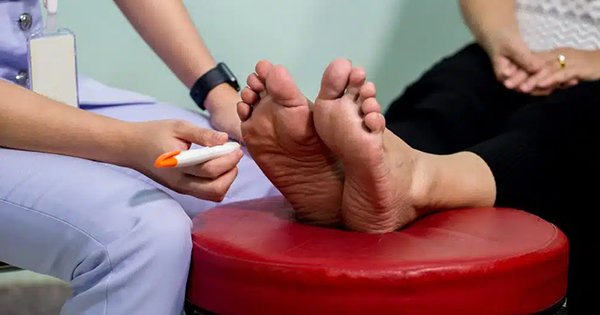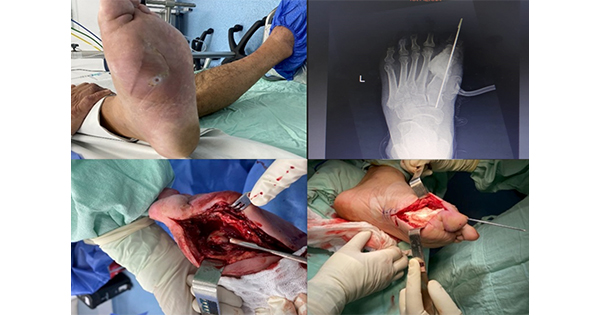Diabetic Foot Syndrome (DFS) is a multifactorial condition often requiring surgical intervention to heal (Lavery et al, 2016). Surgical procedures aim to preserve the foot’s functionality and/or prevent ulcer recrudescence. Frequently, these goals require leaving residual lesions of the forefoot, such as in open trans-metatarsal (TMA) or open rays amputations (RA). Different techniques, procedures and devices are used during the whole ante- and post-surgical healing process. Polydeoxyribonucleotide (PDRN) is a mixed preparation of polymers of different lengths, ranging from 50 and 2,000 base pairs (bp), used as a stimulating agent for tissue repair. This preparation has been shown to have effects on cell growth and on the activity in different cell lines (Guizzardi et al, 2003; Raposio et al, 2008; Veronesi et al, 2017) and tissues, including skin lesions (Valdatta et al, 2004; Veronesi et al, 2017).
In vivo, PDRN is cleaved by membrane enzymes to provide deoxyribonucleotides that can increase cell activity and proliferation via the stimulation of nucleic acid synthesis through the salvage pathway and through the bond with purinergic receptors (Bowler et al, 2001; Bitto et al, 2008; Galeano et al, 2008). Evidence from previous studies suggested that PDRN acts as an agonist on the adenosine A2A receptor, and was able to improve the healing process by increasing the expression of vascular endothelial growth factor (VEGF) and angiopoietin-1. The result is the stabilisation and the maturation of newly formed vessels (Bitto et al, 2008; Galeano et al, 2008; Minutoli et al, 2012).
Sodic-salt DNA fragments preparations (SSDF) are a mixture of purified and depolymerised sodic-salt of deoxyribonucleic acid (DNA) extracted from the gonadic tissue of sturgeons that proved to be a valuable tool in preclinical studies and in different clinical settings (Allen-Gipson et al, 2006; Borea et al, 2016; Lee, 2017; Ahn and Cho, 2018), although there are still few clinical trials, especially in diabetic foot ulcers. Recently, a new SSDF preparation was approved for use in this specific setting, aimed at exerting the reconstructive action of the tissues through cytokines production and nucleotide synthesis.
Aim
The study aims to evaluate the action of SSDF in accelerating the healing processes of diabetic foot residual lesions.
Methods
This case-control study involved patients with established serious forefoot lesions, who had been referred for surgical treatment (Lavery et al, 2016; Guest et al, 2018). The authors enrolled 60 consecutive patients who recently (less then 1 day) underwent open trans-metatarsal or open first-ray amputation aiming to heal a non-responding forefoot lesion of grade 3D Texas University Classification (Lavery et al, 1996) and aiming to salvage the rearfoot.
A total of 68 patients were screened for enrollment; five patients did not meet the requirements and three patients refused to participate. Of the 60 enrolled patients, 40 underwent open trans-metatarsal amputation and 20 underwent open first ray amputation. Inclusion criteria were: age >18 years, recent (<1 day) surgical procedure of the forefoot involving the use of advanced medications, such as dermal substitutes, presence of type 2 well-controlled diabetes mellitus (this was used as an inclusion criterion because of the relationship between glycaemic control and wound healing [Christman et al, 2011; Xiang et al, 2019]), life expectancy >6 months and a value on the Karnofsky Performance Scale ≥40 (Péus et al, 2013), absence or recently successfully treated peripheral arterial disease defined as angiographic success and increase in transcutaneous oxygen value (PtcO2) of the foretoot of at least 20 mmHg.
Exclusion criteria were: presence of dementia or other conditions limiting the required adherence to complete unload of the treated foot for at least 4 weeks, presence of active cancer, presence of inherited thrombophilic conditions, presence of ulcers in the contralateral limb. General characteristic of the population were as follows: 42 males, 18 females; age 72.3 ± 2.4; BMI 27.2 ± 1.6; hypertensives (n=49), normotensive (n=11); history of CVD (n=24); history of PTA of the ulcerated limb in the previous 12 months (n=18); renal function (KDOQI) 10 patients were normal; nine were stage 1, five were stage 2, 26 were stage 3, four were stage 4 and two were stage 5
(Table 1). General characteristics of patients from both groups did not significantly differ. All patients, according to their clinical needs, underwent correction of ischaemia, osteomyelitis and acute infection, shortly followed (less then 1 week) by the application of synthetic dermal substitute (DS).
Antimicrobial therapy was administered as broad spectrum (ciprofloxacin 500 mg twice a day or amoxicillin/clavulanic acid 875/125 mg three times per day plus clindamycin 600 mg three times per day) until the results of microbial culture of deep tissue biopsy, and for 15 days after the surgical treatment according to antibiogram results.
After DS was integrated (median time of 21 + 1 days), every patient in each group (TMA and RA) was allocated either to the treatment group (S: 20 TMA, 10 RA) or to the control group (C: 20 TMA, 10 RA). The mean surface (wound area -WA- measured in cm2) of the lesion measured at this time (T0) did not significantly differ between the two groups. S-group treatment implied antiseptic solution and the application of SSDF cream and sterile gauzes dressing three times a week for 4 weeks. C-group treatment applied antiseptic solution and sterile gauzes dressings three times a week for 4 weeks. All wound dressings were applied and changed by specifically trained healthcare professionals (diabetic foot unit nurses and podiatrists). The authors evaluated the effects of SSDF application on lesions’ healing rate (HR) and healing time (HT); and on the lesion’s surface reduction (cm2) at 1 (T1) and 4 (T4) weeks after the removal of the dermal substitute. Ulcers were assessed weekly with size measurement through sterile graph paper and photographic documentation.
After the first 4 weeks, all patients continued with their regular follow-up according to their risk class. In terms of statistical analysis, differences between the S-group and the C-group were tested using the HT expressed in weeks and the time path of the wound area (cm2) as variables. For the HT the normality test and the number of samples suggested using a non-parametric Mann-Whitney test and the values of P<0.001 were considered to indicate statistical significance. For the WA, anova tests for the adaptation of linear models to balanced or unbalanced experimental projects were applied, and no significant differences were found. Also for the WA, the t-paired test was applied for the initial and final data with significant P values <0.05. All results were calculated with R (release R-3.3.3 for Windows) by CRAN (R Core Team 2013).
Endpoints
The primary endpoint was wound healing. Secondary endpoints were healing time, reduction in the ulcer surface at 4 weeks, ulcer infection, ischaemia relapse, hospitalisation for any cause and death.
Results
At the stage of univariate analysis of aggregated data, three out of 30 patients from the S-group and seven out of 30 patients of the C-group did not heal due to the recrudescence of infection or an ischaemia relapse. Healing rates did not significantly differ between groups (X-square and Yates tests). The HT, expressed in weeks, was significantly lower in the S-group than in the C-group (5.74 ± 1.16 vs 8.22 ± 2.92; Mann-Whitney, P=0,001). T0 areas were not different between the 2 groups (S 23.59 ± 5.03 vs C 22.50 ± 4.94 T-paired test NS). T1 areas were not significantly different between the groups vs T0 (S 15.82 ± 4.06 vs C 15.39 ± 5.40; T-paired test NS). T4 areas were significantly different between the groups (S 4.06 ± 2.62 vs C 5.67 ± 3.50; T-paired test P<0,05).
Discussion
Diabetic foot syndrome is one of the less known, albeit being one of the most life-treatening, complications of diabetes mellitus, with a survival rate at 5 years after ulceration and amputations that is far worse than the survival rate for both colon and breast cancer (Adams et al, 2018; Guest et al, 2018; López-Valverde et al, 2018). Moreover, healing times are frequently measured in months; during this time span, patients are forced to the complete unload of the foot. This condition equally maims younger individuals who cannot work anymore, and older people who lose their last bit of independence. Surgical procedures are frequently the only option, and tag-team ultra-distal revasculatisation plus conservative surgery often answers the need to both heal and salvage the lower limb, allowing the patient to walk without prostethics. Needless to say, a swift diagnostic and therapeutic process and a fast reepitheliation are key aspects for patient compliance.
Data regarding healing rates in diabetic foot recalcitrant ulcers vastly differ among different countries and studies. Moreover, there are almost no studies available that provide solid data on residual lesions from “open” TMA and RA (Ammendola et al, 2017). Data presented in this paper regarding healing rates are coherent with other results in literature and with previous experiences from the same team. Healing times were significantly lower in the S-group, with a mean healing time that was 18 days shorter (5.7 vs 8.2 weeks), allowing partial load of the foot after 1 month and complete load, with adequate shoes, and normal deambulation in less than 40 days. WA at T1 did not significantly differ between the two groups, while the S-group WA showed a better response at T4 compared to the C-group. These data suggest that the supposed effect of SSDN on wound healing may be mediated by increased local protein anabolism and purinergic cascade, more than by a direct effect of the preparation. This effect is crucial if considering the high prevalence of malnutrition and, especially, proteic malnutrition, in the typical person with diabetes: older, overweight, with poor renal function and proteinuria (Vischer et al, 2010; Sanz París et al, 2013).
Eventually, the multifactorial difficulties that impede diabetic foot ulcers healing and particularly alterations in systemic immune and inflammatory response must be considered (Grossmann et al, 2015; Bonacina et al, 2019). This condition is reflected in an even worse wound microenviroment, which facilitates infections and thwarts healing. A direct effect of SSDN at this level can be speculated based on preclinical and pharmacokinetic studies. More studies with larger numbers and from independent teams are desirable and needed to support or disprove this hypothesis.
Study limitations
Numbers are still scarce; there was no long-term follow-up, nor data on same-site reulceration. In addition, no similar studies currently exist to compare with this one.
Conclusion
This study has highlighted a significantly lower healing time in patients treated with SSDF and a lower residual lesions’ area after 4 weeks when compared to the control group. The smaller lesion area at 4 weeks, compared to the control group, may be intended as normal in the ‘faster’ healing process that characterized the S-group. Lack of statistically significant differences in healing rates was expected, since therapeutic failure rates are low and comparable with previous results by the same team if considered as a whole. SSDF could be considered an adjuvant therapy in the treatment of diabetic foot lesions. Shorter healing times help maximise the effect of revascularisation and prevent the ‘compliance exhaustion’ that is frequently witnessed, especially in chronic and recidivating diseases, such as diabetic foot syndrome.




